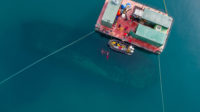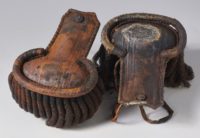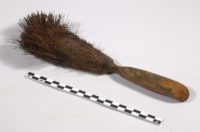In just three weeks, underwater archaeologists from Parks Canada have recovered more than 350 artifacts from the wreck of the HMS Erebus, one of the two vessels of the 1845 Sir John Franklin expedition that came to a tragic end. Between August 20th and September 12th, 2019, Parks Canada’s Underwater Archaeology Team made 93 dives to the wreck, spending a total of 110 hours in the cold Arctic waters of Nunavut.
 New gear made it possible for this season’s excavation to dive for longer periods. The diving support barge Qiniqtiryuaq (meaning “searching for some thing or person which was lost”) was moored with two three-ton anchors right over the wreck. Hoses from the barge supplied divers with air so they didn’t have to carry heavy tanks. Other hoses ran warm water into the divers’ suits. With these two key advantages, divers were able to double the average time spent exploring the wreck in each plunge. The barge also served as an on-site field lab where team members could immediately record every object brought to the surface.
New gear made it possible for this season’s excavation to dive for longer periods. The diving support barge Qiniqtiryuaq (meaning “searching for some thing or person which was lost”) was moored with two three-ton anchors right over the wreck. Hoses from the barge supplied divers with air so they didn’t have to carry heavy tanks. Other hoses ran warm water into the divers’ suits. With these two key advantages, divers were able to double the average time spent exploring the wreck in each plunge. The barge also served as an on-site field lab where team members could immediately record every object brought to the surface.
This year’s excavation efforts focused on two areas along the port side of the lower deck – – an officer’s cabin for the third Lieutenant, and the captain’s steward’s pantry. Within these two adjacent areas, enclosed drawers in fitted cabinets and the remains of cupboards were found, in which a trove of stored artifacts were revealed. All newly discovered artifacts from HMS Erebus and HMS Terror are jointly-owned by the Government of Canada and Inuit.
Parks Canada’s Underwater Archaeology Team uses water induction dredges, trowels, and sometimes light hand-fanning to carefully remove sediments from around buried artifacts, exposing them for mapping, photography, and recovery.
Artefacts from the captain’s steward’s pantry included an abundance of ceramic tableware and beverage containers among other, more personal items such as clothing, a toothbrush with intact bristles and remnants of an accordion.
The captain’s steward was Edmund Hoar, a young man of 23 when Erebus began its ill-fated voyage. His job was to tend to the captain’s table so the pantry was where he stored what he needed to serve the captain’s meals. Archaeologists also found his lead stamp bearing Hoar’s name in the pantry.
 One particularly stunning find preserved in the cold waters is a pair of epaulettes found in a cabin on the lower deck. It has to be confirmed, but archaeologists believe they have belonged to Third Lieutenant James Walter Fairholme. Other than that, the cabin was pretty much empty, as were the ship’s storage areas. Other spaces were still complete with furniture and filled cabinets.
One particularly stunning find preserved in the cold waters is a pair of epaulettes found in a cabin on the lower deck. It has to be confirmed, but archaeologists believe they have belonged to Third Lieutenant James Walter Fairholme. Other than that, the cabin was pretty much empty, as were the ship’s storage areas. Other spaces were still complete with furniture and filled cabinets.
 The artifacts were removed from the barge and first transported to were to Gjoa Haven and Cambridge Bay so the Inuit elders whose oral histories were the key clues that made the original discovery of Erebus in 2014 possible could see the objects. Then they were transported to Parks Canada’s conversation laboratories in Ottawa for stabilization and further study.
The artifacts were removed from the barge and first transported to were to Gjoa Haven and Cambridge Bay so the Inuit elders whose oral histories were the key clues that made the original discovery of Erebus in 2014 possible could see the objects. Then they were transported to Parks Canada’s conversation laboratories in Ottawa for stabilization and further study.